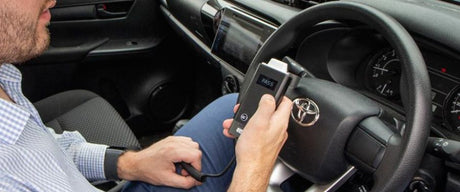Understanding how a breathalyser provides an alcohol reading can give you a deeper insight into accurate breath alcohol testing. In this article, learn how a breathalyser measures breath alcohol concentration (BrAC) and how it is converted to blood alcohol content or blood alcohol concentration (BAC).
How alcohol is measured through breath
When we consume alcohol, the alcohol passes through our body and is absorbed into the blood. In this process, alcohol-saturated blood also passes through our lungs to provide it with oxygen.
Some of the alcohol remains present in the blood after a person has been drinking. The alcohol content then evaporates as it passes through the air sacs or alveoli.
The alveolar air is expelled through the mouth when the person breathes, and this air is picked up by the breathalyser when a person exhales into it.

The alcohol found in a user’s breath sample is directly linked to the amount of alcohol consumed before taking a test.
So in effect, the breath can report the alcohol concentration in the blood.
How a breathalyser measures breath alcohol
Breathalysers use a fuel cell sensor which oxidises alcohol compounts (specifically ethanol) found in a breath sample. It then generates an electric current that is measured by a meter in the circuit to generate a breath alcohol result.
This alcohol reading from a breathalyser is the Breath Alcohol Concentration, or BrAC.
In most breathalysers, this BrAC reading is converted into a BAC reading.
Learn more about this in our article on how a breathalyser works.
So how does it work for a breathalyser that tests your BrAC, but the results obtained are displayed in BAC? Simply put, there is a chemical correlation between the alcohol content of your blood and your breath. Your BrAC results will be converted to blood alcohol concentration (BAC), as explained in the next section.
Converting BrAC to BAC
As mentioned previously, breathalysers first measure the BrAC content in a breath sample. The breath tester must then calculate how much ethanol measured from the expired air sample is in the blood. To do this, the formula takes into account the volume of blood from which the ethanol originated.
To convert BrAC to BAC, breathalysers use a ratio that is based on the blood concentration that evaporates and is expelled in the lungs.
The ratio typically ranges from 2000:1 to 2300:1, however 2100:1 is widely accepted as the standard for most uses, and is the ratio used in Australia.
This ratio means that every 2100ml of air in the breath will have the same alcohol content as 1ml of blood in the body.
Once the processor in the breath tester makes the conversion, the BAC level is expressed as grams per 100ml of blood, i.e. %BAC.
BAC vs BrAC
Both BrAC and BAC are units of measurement used to calculate the amount of alcohol present in one’s system. The difference is that BAC results are typically obtained by taking a blood sample whereas BrAC results are obtained through a breath sample. However, as we have learned above, BAC readings can be converted from BrAC readings using the ratio of 2100:1.
Below are the typical ways in which BAC and BrAC are expressed:
BAC units of measurement
BAC results are typically expressed as mass of alcohol per volume or mass of blood.
%BAC - grams of alcohol in 100 millilitres of blood
mg% - milligrams of alcohol in 100 millilitres of blood
Promille - grams of alcohol in 1 litre of blood
The relationship between these expressions is illustrated as follows:
50mg% = 0.05%BAC = 0.80% Promille
Learn more on what is BAC? To better understand the science behind blood alcohol content, the factors that affect it, how it’s measured, and laws surrounding the legal limit of below 0.05%BAC.
BrAC units of measurement
BrAC results are typically expressed directly as the weight of alcohol per volume of breath sample.
mg/litre - milligrams of alcohol in 1 litre of breath
mg/210L - milligrams of alcohol in 210 litres of breath
g/210L - grams of alcohol in 210 litres of breath
µg/100mL - micograms of alcohol in 100 millitres of breath
The relationship between these expressions is illustrated as follows:
100mg% = 0.48 mg/L = 100 mg/210L = 0.1 g/210L = 48µg/100mL
|
Blood Alcohol Concentration (BAC) |
Breath Alcohol Concentration |
|||||
|
mg% |
%BAC |
%Promille |
mg/L |
mg/210L |
g/210L |
µg/100mL |
|
10 |
0.01 |
0.10 |
0.05 |
10 |
0.01 |
5 |
|
20 |
0.02 |
0.20 |
0.10 |
20 |
0.02 |
10 |
|
30 |
0.03 |
0.30 |
0.15 |
30 |
0.03 |
14 |
|
40 |
0.04 |
0.40 |
0.19 |
40 |
0.04 |
19 |
|
50 |
0.05 |
0.50 |
0.24 |
50 |
0.05 |
24 |
|
60 |
0.06 |
0.60 |
0.29 |
60 |
0.06 |
29 |
|
80 |
0.08 |
0.80 |
0.38 |
80 |
0.08 |
38 |
|
100 |
0.10 |
1.00 |
0.48 |
100 |
0.10 |
48 |
|
110 |
0.11 |
1.10 |
0.52 |
110 |
0.11 |
52 |
|
150 |
0.15 |
1.50 |
0.71 |
150 |
0.15 |
71 |
|
200 |
0.20 |
2.00 |
0.95 |
200 |
0.20 |
95 |
|
300 |
0.30 |
3.00 |
1.43 |
300 |
0.30 |
143 |
In Australia, BAC is still widely used when referring to our legal drink-driving limit i.e. 0.05%BAC. That’s why personal breathalysers still use %BAC as the unit of measurement when providing an alcohol reading.
With the latest Australian Standard AS3547:2019 update, Australian law enforcement and workplace breathalysers have switched to BrAC instead, using g/210L as the unit of measurement. However, the important number still remains the same, as the legal limit of 0.05%BAC after being converted to BrAC is 0.05g/210L.
Understanding the differences between BAC and BrAC is beneficial in comprehending the efficiency of breathalysers and the accuracy of breath testing. Although the most accurate way to measure your BAC is through a blood test, a breathalyser provides an accurate, non-invasive alternative that you can use anytime and anywhere.
References
Burke, Barbara A. Journal of College Science Teaching. Measuring Breath Alcohol Concentrations. Washington: Dec 1991. Vol 21, Issue 3; p 176.





